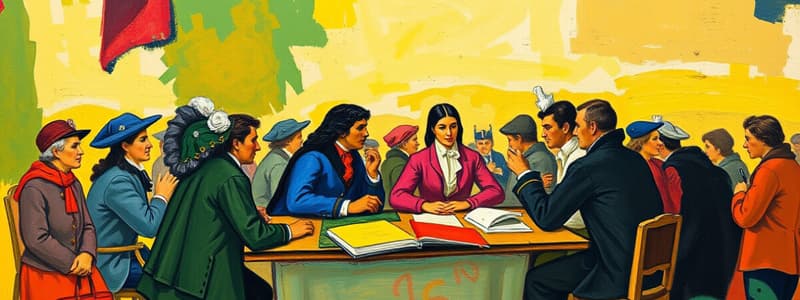Podcast
Questions and Answers
What is the Rush-Bagot Agreement?
What is the Rush-Bagot Agreement?
- A treaty for fishing rights between the U.S. and Britain
- An agreement limiting naval power on the Great Lakes (correct)
- A proclamation by James Monroe
- A settlement of new North American borders
What did the Convention of 1818 settle?
What did the Convention of 1818 settle?
Fishing rights and abolished new North American borders
Who was James Monroe?
Who was James Monroe?
The fifth president of the United States and negotiator of the Louisiana Purchase
What was the Adams-Onís Treaty?
What was the Adams-Onís Treaty?
Who is Simon Bolívar?
Who is Simon Bolívar?
What is the Monroe Doctrine?
What is the Monroe Doctrine?
What does nationalism mean?
What does nationalism mean?
Who was Henry Clay?
Who was Henry Clay?
What was the American System?
What was the American System?
What is the Cumberland Road?
What is the Cumberland Road?
What was the Erie Canal?
What was the Erie Canal?
What does the Era of Good Feelings refer to?
What does the Era of Good Feelings refer to?
What is sectionalism?
What is sectionalism?
What was the Missouri Compromise?
What was the Missouri Compromise?
Who is John Quincy Adams?
Who is John Quincy Adams?
Who was Washington Irving?
Who was Washington Irving?
Who was James Fenimore Cooper?
Who was James Fenimore Cooper?
What was the Hudson River School?
What was the Hudson River School?
Who is George Caleb Bingham?
Who is George Caleb Bingham?
Who was Thomas Cole?
Who was Thomas Cole?
Flashcards are hidden until you start studying
Study Notes
Key Agreements and Treaties
- Rush-Bagot Agreement: Limited naval power on the Great Lakes between the U.S. and British Canada.
- Convention of 1818: Resolved fishing rights and established borders between the U.S. and Great Britain in North America.
- Adams-Onís Treaty: Spain ceded East Florida to the United States, enhancing U.S. territorial claims.
Key Historical Figures
- James Monroe: Fifth U.S. President and key negotiator of the Louisiana Purchase, involved in significant policy developments including the Monroe Doctrine.
- Simon Bolívar: South American revolutionary known as the "Liberator," fought for independence and gained support from U.S. leaders.
- John Quincy Adams: Son of President John Adams and served as the secretary of state to Monroe; played a pivotal role in formulating the Monroe Doctrine.
- Henry Clay: Influential American politician, known as the "Great Pacificator" for his role in the Missouri Compromise.
Key Doctrines and Policies
- Monroe Doctrine: A statement by President Monroe against further colonization in the Americas; any foreign intervention seen as hostile.
- American System: Proposed by Henry Clay, aimed at raising tariffs to fund national infrastructure improvements.
Economic and Cultural Developments
- Era of Good Feelings: A period of national peace and pride from 1815 to 1825, characterized by political unity and economic growth.
- Sectionalism: A growing commitment to regional interests over national unity, leading to tensions between the North and South.
- Missouri Compromise: Allowed Missouri to join as a slave state and Maine as a free state; prohibited slavery in territories north of latitude 30.
Transportation and Infrastructure
- Cumberland Road: The first federally funded road, construction started in 1815, aiding western expansion.
- Erie Canal: Connected Albany to Buffalo, New York, enhancing trade and transportation routes.
American Literature and Art
- Washington Irving: Early American satirical author, recognized globally for his work.
- James Fenimore Cooper: Notable novelist for works like "The Last of the Mohicans," focusing on American themes and the West.
- Hudson River School: A group of mid-19th century artists whose work highlighted American landscapes, reflecting nature's beauty.
- George Caleb Bingham: Painter known for everyday life scenes in the American West.
- Thomas Cole: Founder of the Hudson River School, influential in American landscape painting.
Studying That Suits You
Use AI to generate personalized quizzes and flashcards to suit your learning preferences.




